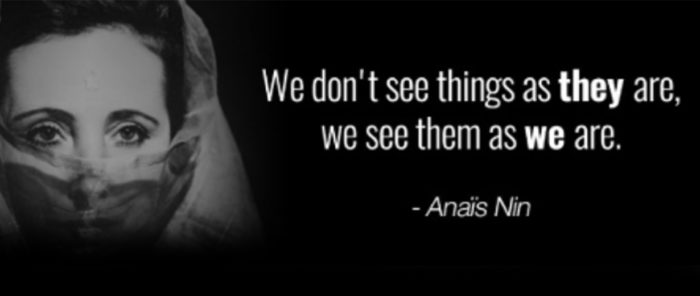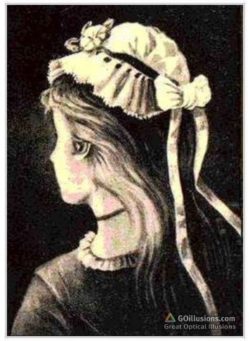
Anais Nin – US (French-born) author & diarist (1903 – 1977). Source – Goalcast.
I told the old Indian story of the 6 blind men (and 7th blind man) – partly to examine the meaning of ‘frame of reference’.
It is said that six blind men were presented with an elephant, a creature of which they had no previous knowledge, and each went about discovering what said elephant was.
The first felt the elephant’s trunk, and decided that the elephant was like a snake. The second touched the smooth surface of its tusk, and was impressed to discover that the elephant was a hard, spear-like creature. The third blind man, standing beside the elephant’s slowly flapping ear, felt the ear itself and determined that the elephant was a sort of living fan. Fourth came a man who touched the elephant’s legs, and therefore decided that it was like a huge tree. However, the fifth man, felt its side and thought that the elephant was like a wall. After feeling its tail, the sixth decided it was nothing but a frayed piece of rope.
These six blind men went back to their village and each acquired followers in the manner of religious teachers. Their devotees would then argue with one another, the snake school of thought competing with adherents of the fan doctrine, the rope philosophy in conflict with the tree trunk faction, and so on.
The only person who did not join in these debates was a seventh blind man, much older than the others, who had visited the elephant after the other six.
While the others rushed off with their separate conclusions, the seventh blind man had taken the time to pet the elephant, to walk all around it, to smell it, to feed it, and to listen to the sounds it made. When he returned to the village and found the populace in a state of uproar between the six factions, the old man laughed to himself: he was the only person in the village who was not convinced he knew exactly what an elephant was like.
Our frame of reference affects how we see and evaluate things, and quite often we will see, evaluate and understand the same object, person or occurrence differently from others.
We can learn many things from the 6 blind men story – for me at the talk, one was important to highlight:
Our frame of reference affects how we see and evaluate things, and quite often we will see, evaluate and understand the same object, person or occurrence differently from others. The six men’s understanding of each part of the elephant was correct, but none of them understood what an elephant was. The 7th blind man took time to understand the elephant and knew more about it than any of the others but was open-minded enough to accept that he still had a lot to learn.
I talked a little about how our own personal frame of reference comes from our social upbringing and life around us (family, school, nation, gender etc.). So, everyone sees things differently, everyone’s frame of reference is different. We judge according to our subconscious assumptions and if people or their actions don’t satisfy our assumptions, we form negative impressions. This is dangerous as it leads to stereotyping.

Young woman, old woman, cat.
So, what should we do? What advice did I offer?
We need to “step out” of our own cultural frame of reference. There are 2 ways that we can do this:
The 1st way, as illustrated by this quote by cultural anthropologist Fons Trompenaars, is to step out physically.
“A fish only discovers its need for water when it is no longer in it. Our own culture is like water to a fish. It sustains us. We live and breathe through it.”
So the 1st way is physical, to move to another country (find your Makoto), but you don’t have to move to another country. As culture has many layers you can move to a different company, department, industry, get a new group of friends, join a new team, take up a new hobby etc. This will help you to understand both your old and new cultures and frames of reference.
The 2nd way is mentally. Challenge yourself and your thinking and discover and change your frame of reference:
- Your world is not the only world
- Place yourself in someone else’s shoes
- Listen to and try to understand others
- Accept that nobody knows everything
- Do not assume everything is either right or wrong
- Do not assume anything you don’t understand
- Continually seek knowledge and education
- Ask yourself questions
Of course, it is best if you can combine both methods.
The title of my talk “Stepping out on a cultural journey” had two meanings. The first being “beginning a journey of cultural understanding (both physical and mental)” – and referring to my own personal journey, and the second is the idea of “stepping out of our cultural frame of reference”. It’s like physically stepping out of our body, looking at ourselves and discovering our own bias and assumptions and trying to become more open-minded. Evaluating and understanding ourselves and being open-minded are the first steps we must take on a journey to cultural competence.
I left the audience with a question. The answers to which are helping me with my own continued learning. I asked them to look at the picture and to tell me what they saw.

Exploring Culture: Exercises, Stories and Synthetic Cultures. Geert Hofstede, Gert Jan Hofstede, and Paul Pedersen.
What was their interpretation of what was happening? At the end of all the talks many of the audience shared their interpretations with me and I shared with them the interpretations of different genders and ages from 11 countries. One lady from the audience also really opened my eyes as she discussed with me what she saw. Our conversation went something like this:
Her: “The man on the left is giving …”
Me: “You mean the man on the right? Right?”
Her: “No, I mean the man on the left.”
Me: “Wow! That’s a man on the left?”
Her: “Yes. They are both men. The one on the left is definitely a man. The shoulder is not right for it to be a woman.”
So, let me ask you, what do you see?